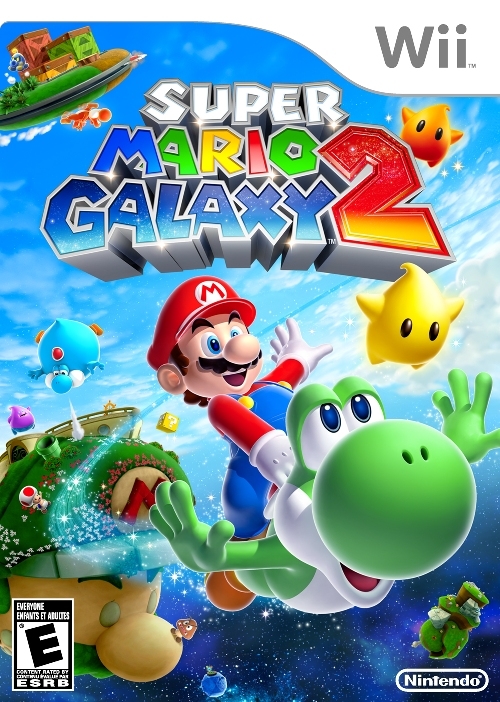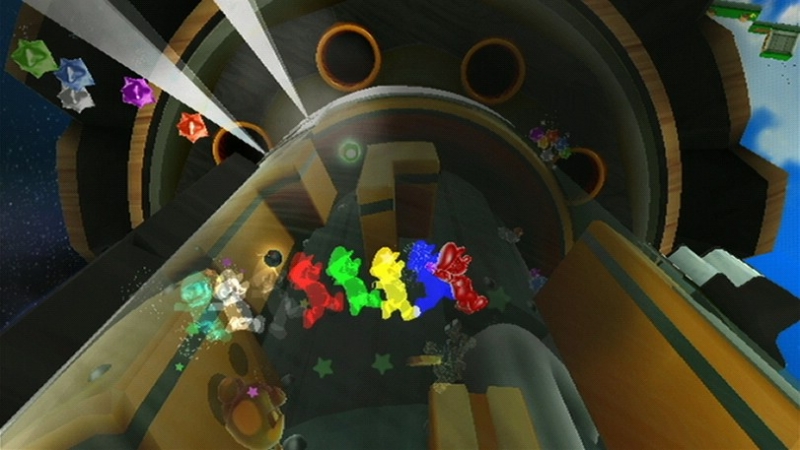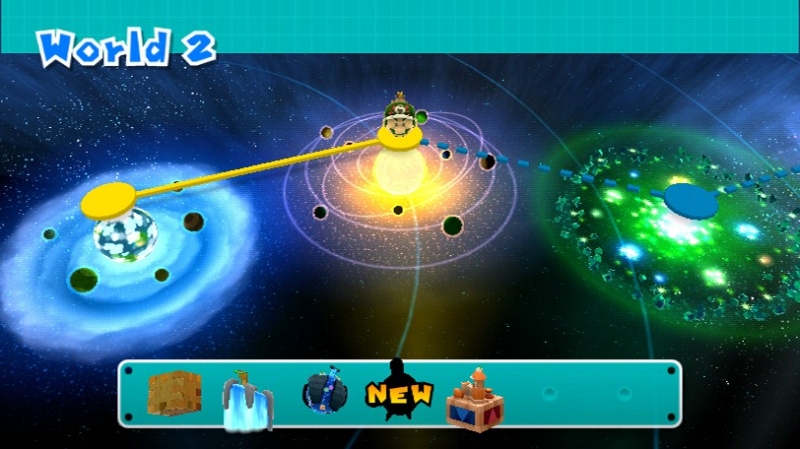Existing User Log In
New User Registration
Register for a free account to gain full access to the VGChartz Network and join our thriving community.





America - Front


America - Back

Time after time, Mario and the diligent masterminds at Nintendo responsible for him have proven that he can do anything. Arguably the eponymous face of gaming, the chubby plumber from Brooklyn has conquered everything from fighting games to racing, all while dazzling critics and dominating the sales charts. Yet Mario’s most remarkable accomplishment is perhaps his ability to stay fresh and far ahead of the curve even as he retains the enjoyable foundation that made his original games so captivating. Super Mario Galaxy 2 is proof positive of that very capacity and is an incredible game to boot.
It is also a game no one expected. The first direct sequel to a Mario platformer in decades, Galaxy 2 surpasses the excellence of the award-winning Super Mario Galaxy and the return to 2D interlude New Super Mario Bros. Wii. Immediately upon playing Super Mario Galaxy 2 you will not only rediscover what made its predecessor an instant classic, but also a coat of polish and refinement that sets this adventure apart from just about every other game out there.
The inciting incidents that set this game in motion are almost cloyingly familiar. Princess Peach invites Mario to the castle to watch the anticipated cosmic festivities along with the delightful promise of cake. Then as he is wont to do, Bowser, maintaining the massive stature he acquired at the end of NSMB Wii, kidnaps Peach and only seeks to grow more colossal. Mario unites with another lost Luma and hops aboard a space-vessel giving chase to Peach and her malevolent captor. You are forgiven for pondering whether a more novel set up could have been included but chances are you will not care after the game proper begins.

The first galaxy you will explore is among a fleet of warships firing Bullet Bills into the vast starry beyond. Not only does it serve to reacquaint the player with all the jumping and butt stomping action expected of 3D Mario games but also the joys of flight and traversing planets with competing bodies of gravitational force. From there on you will be hard pressed to put the controller down again. The sprawling adventure that ensues is filled to the brim with innovative and exciting new approaches to platforming that stretch gameplay concepts farther than you could ever envision. The controls remain as tight as ever, allowing you to exploit Mario’s acrobatic skill to the fullest. The configuration remains unchanged; you shake the Wiimote to perform a Spin Attack and use the pointer to collect and shoot star bits using the B trigger.
Some of the best segments from Super Mario Galaxy return in wonderfully expanded form. There are more glide races, ball rolling, ice-skating, and gravity bending puzzles to test your wits and reflexes. Some of these portions come with their own context sensitive motion controls that present themselves clearly and are relatively simple to grasp. Enough about what’s the same though, there is plenty of unique attributes to Super Mario Galaxy 2 that truly make this game worth playing.
One thing you will notice quickly is the game’s new central base of operations, Starship Mario. As the name suggests your new hub is a space ship shaped in Mario’s image. It functions somewhat similarly to Rosalina’s observatory form the first game; as you progress, it becomes more elaborate and inhabited. The main difference though is the presence of a world map akin to that of the 2D Mario games. This streamlines navigation between the many levels nicely and makes it easier to keep track of which stars to hunt. At the helm of Starship Mario is Lubba, a plump and wisecracking purple Luma who offers advice and wisecracking dialogue throughout your quest.
Of course, the most significant gameplay addition is the one prominently featured on the cover art: Yoshi. Super Mario Galaxy 2 features the best implementation of Yoshi in a videogame ever. Like the best supporting players in any medium, the lovable green dinosaur is utilized neither too much nor too little. Whenever the player comes across a spotted green egg during a level, a smile will appear on their face as they realize something unique is about to happen. Whenever Mario is riding Yoshi, the game’s star-shaped reticule morphs into a red bulb representative of his tongue. Point the remote anywhere and press the trigger to interact with the surroundings, which includes gobbling up enemies to spit them back out or discreetly digest them into Star Bits. Yoshi can also use his elastic tongue to swing from bars or swallow spicy peppers that increase his speed for a short time to make him capable of running up walls. Other uses for Yoshi include pulling back on items to make a new path accessible or eating a fruit that turns him into a giant balloon that steadily floats upwards until he deflates. Some stars are only reachable with Yoshi and whenever that is the case, he reappears at the nearest checkpoint. Yoshi is integral in some of the game’s most exciting boss encounters, not to reveal too much but they involve Bowser Jr. and some daunting robots.

Powerups are one of the main attractions of any Mario game and Super Mario Galaxy features them in droves. Not only do most of the suits from the original return and are put to sparklingly good use, but there are some incredible new ones. The Cloud suit allows Mario to step on cloud platforms and conjure his own with a shake of the Wiimote. Cloud Mario can only summon up to three cloud platforms at a time and they do disappear after a short time so it is not a free pass to jump around carelessly. With a flick of the remote, the Rock suit transforms the mustachioed hero into a rolling boulder strong enough to smash through objects and crush enemies. Rock Mario provides some tricky but fun navigating challenges as well as an action packed take on galactic bowling. Then there is my favorite new powerup, the drill. When in possession of this nifty tool Mario can burrow through certain surfaces straight to the other side of a planet, defeating any enemy that may be in the way. The powerups both old and new only appear when appropriate and add an exciting flavor to whatever task they may be associated.
Another gameplay addition sure to please fans is the option of occasionally playing as Luigi. Only playable as a bonus after collecting all the stars in the first game, here Luigi can be found randomly at the beginning of some galaxies. Luigi jumps higher and runs faster than Mario runs but he cannot jump as far. Playing as Luigi is never mandatory to obtain a star but is still a neat extra diversion. Speaking of diversions, get ready to play a ton of minigames. A highly competitive chimp cleverly named The Chimp makes it his sole mission to challenge Mario with topping his score at various contests like stomping enemies or tackling pop up figures while gliding around on ice.
The objective is to collect enough power stars to fuel Starship Mario’s advance to the center of the galaxy. Expectedly extravagant, but nonetheless mesmerizing level design supplements this now classic arrangement. Mario will encounter worlds that modify themselves with every shake of the Wiimote or to their own rhythm. Other examples include a galaxy that alternates between brief flashes of light and eclipsing darkness and even a welcome reworking of a classic level from Super Mario 64. Even when the game falls back on tried and true customs like collecting silver stars or slide down massive inclines, the core platforming is strong enough to make every obstacle worth your full attention.
As usual, some levels specifically contour to lead you to certain power stars, however other power stars can only be found through exploration. This brings us back to the classic debate involving 3D Mario games and the split between linearity and open world exploration. In my mind, Super Mario Galaxy 2 strikes the perfect balance between the two extremes. Steady progression is assured if you go after the stars with paths already laid out for Mario but inevitably, you will have to return to past levels and search every nook and cranny to amass enough to advance and ultimately complete the game. Pathways to these atypical stars are tucked away ingeniously in pipes obscured by level geography or can be discovered by experimenting with the trails that seemingly lead to nowhere.

Finding hidden stars is at times a lengthy but never unfeasible feat. Much has been said about Super Mario Galaxy 2’s difficulty with claims that it is overly simple and easy. In fact, the difficulty level is exactly where it needs to be. It varies on a star-to-star basis but essentially fits into one of three increments: sweetly short and simple, medium length with perhaps a few unfortunate deaths, and “I swear the Wiimote goes out the window if I die again!” The difficulty escalates at a fair pace so by the end even the most experienced gamers will have their skills tested. An abundance of 1-ups nullifies the need for a lives system. You still receive five extra lives just for speaking to a toad on Starship Mario and there are loads more easily attainable during and between levels. It is entirely possible to play the entire game and never discover what the Game Over screen looks like.
Both Star Bits and Gold Coins return as the primary forms of currency and receive greater emphasis than before. Star Bits’ value extends beyond their function as projectiles. You will need to have a certain balance in order to unlock new levels or to transform hungry Lumas into launch stars. To help you manage your collection a toad on Starship Mario offers a banking service where you can deposit any number of Star Bits and withdraw them later with interest. Similarly, you will need to pay a certain number of coins to open up new challenges. Unlike Star Bits though, you lose all the coins you have earned during a level each time you die. This is worth mentioning because Mario sometimes must collect upwards of 100 coins to pay off a Luma so it can be frustrating to have to back out of a level to find those coins again without dying.
Boss encounters in Super Mario Galaxy 2 are among the best in the series' entire storied run. Large insidious foes do their very best to expunge Mario from their small orbital habitats. Whether the battle is against sinuous dragons or hatching piranha plants, the environment, powerups, and even Yoshi are put to excellent use. The standouts though are the fights with Bowser Jr. that are varied and epic. You will not be able to forget them. Bouts with Bowser are impressive in their own right but I cannot help but feel more could have been done to make each individual encounter more distinct. As it stands, they each come down to dodging the same three attacks and butt stomping a planetoid into his face. They get tougher though, and are still enjoyable to play.

Great all around presentation complements the masterfully executed gameplay design. A vivid blend of primary colors, sense of fluidity, and a grand attention to detail make this one of the most visually arresting games out there. Technically the game runs smooth at a solid 60 frames per second that never falters no matter how much is going on onscreen. It does closely resemble the look of the first game but clearly some textures have been spruced up a bit.
The art direction brings the Mario universe to life so convincingly it feels like a lucid dream. Each galaxy comes to life with its own unique sense of kinetic activity. There is always something new and interesting to look at such as some stunning scenes where Mario gracefully flies through a sea of fiery behemoths and space remains an astonishing backdrop for the adventure once again.
The storybook theme returns albeit in more subtle fashion. Not much happens as far as story is concerned other than a few conversations with Lubba and cutscenes of Starship Mario blasting off into the next world. The writing will not win any awards but it is pleasing and unobtrusive enough that it does not irk you.
On the audio side of things, Super Mario Galaxy 2 reaches the same stratospheric heights of the first. Koji Kondo has once again composed a soundtrack that should please all appreciative ears. Consisting of whimsical new scores and modern updates of memorable classics the soundtrack is sure to evoke all sorts of satisfying emotions. Initially, I was doubtful any musical piece could match my fondness for “Gusty Garden Galaxy” from the original until my ears were exposed to the “Yoshi Star Galaxy” and later on many more tracks that are admirable.

There are not many speaking parts but the voice acting is still good for what it is. The frequent sound effects constantly energize the player reminding them just how responsive the game world is. The Wiimote speaker is put to the same effectual work, providing much needed feedback whenever you shoot a Star Bit or Yoshi eats something.
Okay so we have established Super Mario Galaxy 2 as a great game, but how long does it last? As long as you want it to. If you just want to defeat Bowser and see the end credits, you will need 70 or so stars which equates to 12-15 hours of playtime. There are six worlds total and an additional secret world accessible after beating Bowser. In order to earn all 120 stars you will have to find all the hidden ones you may have looked over. This means collecting Comet Medals found in every galaxy that increases the odds of prankster comets appearing over a level. Accomplishing all that will take somewhere in the realm of 25 hours.
But wait there is more! Beating the game with 120 power stars unlocks a cutscene featuring Rosalina telling a story to a roomful of baby Lumas about green Lumas. Afterwards these green stars are scattered throughout the galaxies waiting to be found. This transforms the game into a lengthy game of hide-and-seek, pleasing because it offers another chance to explore the levels at the player’s leisure.

There are still a few lingering quirks that impede Super Mario Galaxy 2’s march to perfection. The camera, while improved from the first, still provides insufficient control on the player’s end at time leading to unfortunate falls and deaths. We still do not have true multiplayer in a 3D Mario game even after indulging in the 4-player portion of NSMB Wii. The co-op mode returns with some improvements. At any time, a second player can grab a controller and help Mario nab Star Bits and otherwise unreachable items.
Super Mario Galaxy 2 is the complete package. Featuring gameplay that boasts a staggering amount of variety and capable of seamless transition between 2D and 3D with gravity defying results. Owning this game is like being able to access your best day ever at an amusement park whenever you want. There are those who will readily declare it superior to its predecessor, and then there are those like me who believe they are two sides of the same pristine coin. Ultimately, all words are useless because Super Mario Galaxy 1 and 2 are an experience that must be played to fully understand. Once again, Mario and Nintendo prove they are at the top of their game and that their star is ever rising to new and incredible heights.










|
|
|
|
|
|
|
|
|
|
|
|
|
|
|
|
|
drake_tolu
posted 09/07/2014, 02:37
7,500,000 lifetime, maybe 8,000,000. Fantastich game, better exclusive for Wii U. Message | Report |